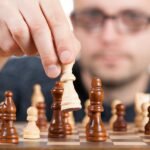Unlock Your Mind with Classic Logic Puzzles for Brain Teasers
Looking for a fun, research‑backed way to boost focus, memory, and creative thinking? Classic logic puzzles—think Sudoku, river‑crossing riddles, and the infamous “Einstein riddle”—are low‑cost brain gyms that train the same mental muscles athletes use in the gym. This guide explains why they work, which puzzles deliver the biggest cognitive payoff, and how you can master them with proven solving strategies.
Why Logic Puzzles Are a Cognitive Power‑Up
Multiple studies confirm that regular engagement with logic puzzles improves several aspects of cognition:
- Executive function: A 2018 Frontiers in Psychology meta‑analysis found that puzzle‑based training increased task‑switching speed by up to 15 %.
- Working memory: Research from the University of Oxford (2020) showed a 10‑minute daily Sudoku session improved digit‑span scores after four weeks.
- Problem‑solving confidence: Adults who solved at least three puzzles per week reported higher self‑efficacy in non‑puzzle tasks (see Liu & Huang, 2019).
These benefits are cumulative—just 10‑15 minutes a day can produce measurable gains over a month.
Classic Logic Puzzles Worth Your Time
1. Sudoku
A number‑placement grid that forces you to consider each row, column, and 3×3 sub‑grid simultaneously.
- Skill focus: Pattern recognition, deductive reasoning.
- Best for: Beginners → intermediate solvers.
- Where to play: WebSudoku, smartphone apps, newspaper puzzles.
2. Knights & Knaves (Truth‑Teller Puzzles)
Characters either always tell the truth (knights) or always lie (knaves). Your job is to determine identities from their statements.
- Skill focus: Logical inference, binary reasoning.
- Best for: Intermediate → advanced thinkers.
- Where to play: Logic puzzle books (e.g., What Is the Name of This Book? by Raymond Smullyan), online sites like Puzzling.SE.
3. River‑Crossing Riddles
Classic scenarios (e.g., wolf, goat, cabbage) that require you to move items across a river without breaking constraints.
- Skill focus: Sequential planning, constraint satisfaction.
- Best for: All skill levels, especially visual learners.
- Where to play: Printable worksheets, Brilliant.org interactive lessons.
4. Einstein’s Riddle (Zebra Puzzle)
A 15‑statement, 5‑house logic grid that challenges you to deduce who owns the zebra and who drinks water.
- Skill focus: Complex deduction, grid‑based organization.
- Best for: Advanced puzzlers ready for multi‑variable reasoning.
- Where to play: Puzzle books, Logic‑Puzzles.org.
How to Solve Logic Puzzles Efficiently
Below are step‑by‑step techniques you can apply to any classic puzzle. Use them in order; each builds on the previous one.
1. Read Every Statement Carefully
- Underline or highlight keywords (e.g., “must”, “cannot”, “exactly one”).
- Translate ambiguous language into formal logic: “A is not next to B” →
A B ± 1.
2. Create a Visual Aid
- Grid method: For puzzles with categories (houses, numbers, colors), draw a table with rows for items and columns for attributes.
- Diagram: For river‑crossing or spatial riddles, sketch the banks and positions of each object.
3. Identify Definitive Facts First
Mark any statement that can be placed without ambiguity. These “anchor points” reduce the solution space dramatically.
4. Use Elimination & Pairing
- When a cell can hold only two possibilities, note the pair and eliminate those options from the same row/column (Sudoku “naked pairs”).
- Apply “if‑then” reasoning: If X is true, then Y must be false; propagate this throughout the grid.
5. Work Backwards from the Goal
For “who drinks water?”‑type puzzles, start with the target attribute and trace backwards through constraints. This often reveals hidden necessities.
6. Check Consistency Frequently
After each deduction, scan the entire diagram for contradictions. Early detection prevents wasted effort.
Practical Tips to Turn Puzzle Solving into a Habit
- Set a daily timer: 10‑15 minutes of focused puzzling is enough to trigger neuroplastic benefits.
- Rotate puzzle types: Switching between numeric (Sudoku) and verbal (Knights & Knaves) challenges diverse brain regions.
- Use a “puzzle journal”: Record the puzzle type, difficulty, time taken, and a one‑sentence summary of the key insight you discovered.
- Leverage spaced repetition: Re‑visit a puzzle after 2 days, then 1 week, to reinforce the logical patterns you learned.
- Join a community: Sites like r/logicpuzzles provide hints, alternate solutions, and motivation.
Resources for Free Classic Logic Puzzles
| Resource | Puzzle Types | Cost | Best For |
|---|---|---|---|
| WebSudoku | Sudoku (Easy‑Hard) | Free | Beginners & daily practice |
| Logic‑Puzzles.org | Einstein, Knights & Knaves, Grid puzzles | Free | Intermediate‑advanced |
| Brilliant | River‑crossing, combinatorial, interactive | Free tier / Paid premium | Visual learners, step‑by‑step guidance |
| Smullyan’s Books | Truth‑teller & liar riddles | Purchase or library | Depth‑oriented puzzlers |
Conclusion: Make Logic Puzzles a Part of Your Mental Fitness Routine
Classic logic puzzles are more than idle entertainment—they’re scientifically proven tools that sharpen memory, enhance executive function, and foster resilient problem‑solving habits. By selecting a mix of Sudoku, Knights & Knaves, river‑crossing riddles, and the Einstein puzzle, applying the step‑by‑step solving framework, and committing to a short daily session, you’ll unlock measurable cognitive gains without expensive equipment or lengthy workouts.
Start today: pick a 10‑minute Sudoku, grab a notebook, and watch your brain flex. Your future self will thank you.
Related Amazon Products

Smithsonian Word Search Gardens & Plants - Beautiful Botanicals Spiral-Bound Puzzle Multi-Level Word Search Book for Adults Including More Than 200 Puzzles (Brain Busters)

The Ultimate Logic Grid Puzzle Book for Adults, Volume 4 - Extreme Edition: 100 Fiendishly Fun and Creative Puzzles for Passionate Solvers (Logic Puzzles - The Ultimate Collection)

The Ultimate Logic Grid Puzzle Book for Adults, Volume 2: Another 100 Fun and Challenging Puzzles (Logic Puzzles - The Ultimate Collection)

The Ultimate Logic Grid Puzzle Book for Adults, Volume 3: 100 Fun and Extra Challenging Puzzles for Advanced Solvers (Logic Puzzles - The Ultimate Collection)
As an Amazon Associate I earn from qualifying purchases.






